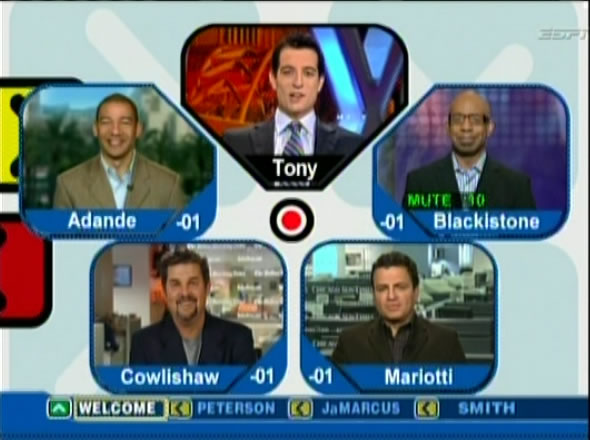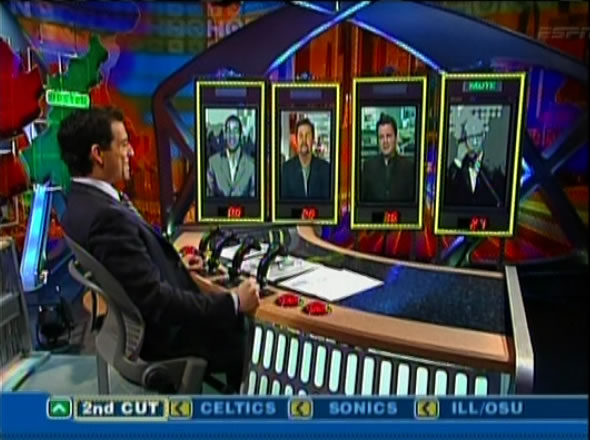Pardon the Competition: ESPN Turns Sports Talk Into a Game

In a recent issue of FLOW, John Jordan hypothesized about what function sports commentators serve given their ubiquity in sports TV programming. This essay is not a retort to Jordan’s argument1, but does address the issue of how one sports network, ESPN, uses its sports commentators to reinscribe the brand of ESPN by actually making sports talk into competition.
ESPN runs two programs daily–Around the Horn and Pardon the Interruption–that are talk shows based upon current sports issues and, more specifically, sports highlight packages. The same packages are recycled continuously throughout the day on virtually all of ESPN’s media platforms. While packages/agendas are a staple structuring mechanism for any media organization, ESPN actually turns the discussions on these two programs into sporting competitions, thus reasserting the sporting brand of ESPN.
Shows such as Around the Horn and Pardon the Interruption create competition between the panelists with scores and, ultimately, winners and losers. Around the Horn centers on “competitive banter” and claims to be the “show that scores the argument.” ATH host Tony Reali sits at a command module, complete with joysticks that “score” points for the most salient and well-argued retorts. Reali faces a bank of four video monitors featuring sports writers from across the USA (also represented by a map in the studio’s mise-en-scene), and the competition ensues that is described by Reali as “ten topics, one winner.” The mise-en-scene of ATH enacts many familiar environments to TV consumers — the remote control, the video game module and Reali’s spectatorship and selection of content/panelist.

Reali introduces segments such as “Buy or Sell” and “Out of Bounds,” during which the respondents make arguments that Reali either rewards or discounts with points. After the initial three segments, Reali “cuts” a panelist by freezing his/her frame (Reali also “mutes” participants as needed, again reinscribing the consumer’s experience of TV’s flow) and the competition continues between the remaining three. A final “cut” results in the two respondents with the highest scores for the day. The final two continue to the “Showdown”—a rapid-fire, head-cutting duel of various sports/current events topics, in which Reali awards points for creativity and rhetorical moxie.
ATH is a postmodern enactment of modern TV viewership2. Reali controls the show with a series of remote controls and awards points for substantive retorts. Panelists are often pitted against one another in a split-screen formation to display their points. This setup also serves to narrativize the sporting contestation, much in the same way that sporting events are televised and structured around the principles of continuity editing and screen direction. By aligning opponents on opposite sides of the televisual “field,” the commentators simulate the competitive struggles that they are opining.

Both ATH and PTI imitate another “competitive” enactment of what sports consumers (viewers and fans) understand: the dialogue of sports talk. In the world of sports talk (radio, TV and new media), competitive banter involves an encyclopedic knowledge of statistics, schedules, injuries, history, etc., to make a compelling argument about whatever the current topic may be. For example, ATH participants can’t simply discuss Tiger Woods’ latest golfing victory, but rather must outdo one another with a litany of facts and figures to “win” the argument and points. ATH is based upon the subject of various sporting competitions (though heavily favoring the USA’s big three of football, basketball and baseball), and is itself a competition. Daily “winners” of ATH taunt the other participants first with their “prize,” which is “Facetime” — a 30-second freestyle on their topic of choice — and second with their “all-time wins” in a display of competitive records and statistics that mimics the sports they cover as journalists.
Immediately following ATH is a second ESPN “competitive banter” show, Pardon the Interruption. PTI’s namesake is again a postmodern, intertextual address of the interruptive nature of television and the two hosts, The Washington Post’s Tony Kornheiser and Michael Wilbon, carry out this edict by constantly interjecting into each other’s arguments. Interestingly, ATH host Reali is relegated to “stat boy” on PTI. Reali’s function on PTI is (again) to moderate a competitive segment of PTI called “Odds Makers.” In this segment, the hosts give their percentage chances to the relative likelihood of some upcoming sporting endeavor (“100% that Ricky Williams will fail another drug test!”).
[youtube]http://youtube.com/watch?v=Gp9MscpppkI[/youtube]
This segment is also structurally related to the commonly understood “betting lines” or the “point spread”–betting options available to gamblers–of many major sporting events. Reali’s role as “stat boy” again reinscribes the event of television in the show’s penultimate segment “Errors/Corrections.” Usually, introduced by the hosts as, “now it’s time to find out where we messed up,” Reali proceeds to “correct” any erroneous assertions (inaccurate records, statistics, etc.) made the hosts throughout the show’s rapid-fire tete-a-tete.
Both ATH and PTI visually and narratively try to emulate the sporting endeavors they observe and report upon. The programs often seem very similar to game shows and are in fact structured in similar fashion to something akin to Survivor. The significance lies in ESPN’s strategy to create competition between its commentators. Other commentary/news programming on ESPN function as talk shows or panel discussions–Outside the Lines or The Sports Reporters–but the other shows do not assign point values nor do their participants gloat as “winners” and protest as “losers.”
Perhaps in ESPN’s ever-converging and expanding media empire, the creation of programming that mimics the niche content (sports) of the network is merely another enactment of synergy and convergence. As aforementioned, a consumer of ESPN’s daily agenda/packages can determine what “points” will be bandied about during the course of a news day by observing the initial packages of morning programming such as Sportscenter or Cold Pizza/First Take. These programs are much more along the standard news package or commentary programs, whereas ATH and PTI are something innovative. Perhaps ESPN’s producers realize that their programming niche is competition and by creating competitive programs that ape sporting contests, ESPN is simply creating more of what their audience knows and wants: winners and losers.
Image Credits
1. Screen capture provided by author, made November 2007.
2. Screen capture provided by author, made November 2007.
3. Screen capture provided by author, made November 2007.
4. Home Page image.
Works Cited
Cossar, Harper. “Televised golf and the creation of narrative,” in Sports in Film, Eds. Ron Briley, Michael K. Schoenecke and Deborah A. Carmichael, University of Kentucky Press, forthcoming in 2008.
- I do however feel that announcers provide narrative contextualization for viewers, and I develop this argument for sports announcers (and golf commentators specifically) in Cossar (2007). [↩]
- While ATH is littered with pop culture and sports references, two apparent instances stand out. The show’s name derives from a baseball drill in which infielders throw the ball “around the horn” after recording an out to keep their arms loose. Reali also commonly ends segments and leads into commercial breaks by yelling “Fore!” as is customary for golfers when a ball may be offline and threatening other golfers. It is short for forewarned; again, this is ATH’s intertextual and reflexive assertion that a commercial is forthcoming. [↩]
Watching clips of these shows on YouTube, I was struck by the intensity of the programming. So much yelling! It’s much more dramatic and affective than Jeopardy or other more sedate true “game shows,” so to speak.
I wonder how much performance style plays into how these shows function. I also wonder too about the ongoing effort of channels and networks to cultivate their own on-air “personalities” that serve as a commodity to draw in viewers.
Interesting article. It’s great to see consideration of the television landscape outside of our usual prime-time serialized narrative programs.
I’m very interested in how most viewers interpret the “frame” of these shows: do they really care who “wins” on ATH (which features the same rotating cast of talking heads) or do they merely accept it as a narrative device that allows for sports talk? ESPN.com columnist Bill Simmons even made a joke a few months ago (I can’t find the link now) about how if he could travel back in time to tell his younger self about the future he would be sure to include how ESPN now has talk shows where sports columnists pretend to yell at each other every day. Also, while not overtly competitive in the same way (particularly the scorekeeping), I do think sports journalism is moving in this direction of “in-your-face” commentary. The Jim Rome radio show, the Fox Sports radio network hosts, the “First and Ten” segment on ESPN’s First Take morning show, and all kinds of other sports-related programming are all getting more interested in “dominating” those who disagree with you about, say, who will win the Heisman Trophy. While I find it somewhat depressing, it can’t be denied that it matches the tone of what they’re covering: sports, after all, are all about winning.
I think you have to hand it to ESPN for finding new and creative ways to keep viewers watching the channel when the shows often have similar content and stories to work around. If these competitive shows were not on the channel that would leave room for either some quasi-sport competition (darts or dominoes anyone?) or another hour of Sportscenter. When looking at the alternatives I would much rather watch a Pardon the Interruption, knowing roughly how long until they talk about a story I am interested in, then watch another hour of Sportcenter or darts.
I can’t help but think about how the competitive nature of these shows, (and not just competitive, but in-your-face and aggressively competitive) also reiterate the masculine rhetoric ESPN is continually striving to propagate – through programming, sports selection (so rare to see women’s sports and never at peak hours), commercials, commentators, and even competitive talk shows. I don’t’ think anyone ever questions the masculine nature of athletic competition, but it’s interesting the degree to which everything serves to continually reinforce the hegemonic assumptions about athletes and sports as purely masculine – and therefore in need of aggressive competition. I completely agree with the author, that it contributes to a seamless flow of winners and losers.
Pingback: Dan Patrick’s Backstage Musical: Watching Production in the Age of Media Convergence Harper Cossar / Georgia Gwinnett College | Flow